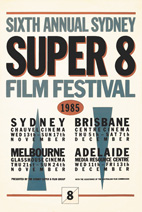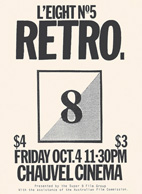 |
Posters, Sydney Super 8 Film Group Courtesy D/Lux/Media/Arts |
Kate, you initiated the first Super 8 film festival with Deb Collins. Your background was a distinctively Sydney 80s mixture of politics, squats and French cultural theory?
KR We both began shooting Super 8 while still in high school, and were very political young people and strong feminists. In 1980, when we established the first Super 8 film festival we were living in the Surrey Street squats...Our imperative was just the politics of getting this stuff up on screen. Deb approached the Sydney Filmmakers Co-op to put the work on. She talked them through their initial response of, ‘Oh Super 8, that is not a valid format.’ They were media makers, content and documentary orientated, and artisanal based. What we represented were the new wave of the tertiary-educated, French theory driven students from UTS. Further down the track I could see that without a strong studio practice the whole thing falls over.
How did the first festival go?
KR It was an unbelievable success. We made a little poster and we photocopied it and just stuck it around in cafés and on posts and people had to mail their work in. We got a huge amount of films and we showed them all. The program was very long and we packed out the Co-op the whole weekend. The Co-op were astounded as they had a lot of trouble getting bums on seats. I think the festivals captured a moment when a whole lot of new forms of aesthetics and signification were starting to bubble away—classic post modernity before the term was being used in Sydney—films such as Stephen Harrop’s Square Bashing, with found footage re-configured, and very well cut.
You then moved to England and connected with the Bristol scene. The festival needed new patronage.
KR Yes, luckily they all appeared in that Brisbane wave. There was a big influx in the late 70s: musicians, artists and social workers. They were really quite smart, sophisticated and articulate, coming out of such a repressive regime as Bjelke Peterson’s. I think it was a natural progression that this new group would take over the next festival.
 |
Posters, Sydney Super 8 Film Group Courtesy D/Lux/Media/Arts |
After successfully applying for a grant from the Australian Film Commission we held the 3rd Sydney Super 8 Film Festival in November 1982 at the Chauvel Cinema in Paddington. The cinema had a capacity of 300 hundred seats. It was full every night and was like that for every annual festival for most of the 80s. I don’t think there were many sophisticated debates around the selection process. We were a test audience, a colosseum forum that voted thumbs up or down.
There was a scene there that grew in sophistication as long as the technology was viable. Over that period a new core of people began to develop with Gary Warner, Virginia Hilyard, Michael Hutak, Catherine Lowing, Andrew Frost and myself. We also did a whole series of Film Readers as well as the festival catalogues and posters, all of which demonstrated a post-do-it-yourself-new-wave aesthetic.
What were some of the political and aesthetic considerations of the filmmakers involved?
MT Andrew Frost, Michael Hutak, Gary Warner, Stephen Harrop and myself all eventually formed Metaphysical TV. We all made films about our relationship with the television screen. We used Super 8 to shoot directly off the screen, reconstructing the material into some personal or perverse work. It all fell into current discussions of post-modern quotation and appropriation. Catherine Lowing was working with a similar sensibility but without the direct relation to television; she was into subcultures, rockabilly, video clip...and dance cultures. Virginia Hilyard was more into a poetics of cinema; she did experiments with expanded live performances. Her work was close to neo-expressionist painting of the time, very visceral and physical.
What did post modernity mean for Sydney Super 8 film scene?
MT I remember the event that crystallised the understanding of postmodernism in relationship to visual art practice was the Futur*Fall conference at Sydney University in 1984. Baudrillard was the keynote speaker. Lots of people identified postmodern concerns in literature, film theory, fine arts, architecture and economics.
For most of the Super 8 filmmakers what appeared as postmodern in their work had come about quite spontaneously. Instead of taking up the previous generation’s tendency to critique entertainment culture and reject it out of hand we savoured it for aesthetic and expressive effect, touched it up in a certain way, rebuilt it to make it even more perfect. To even make it articulate where it had been dumb, and thoughtful where it had been ignorant.
 |
Posters, Sydney Super 8 Film Group Courtesy D/Lux/Media/Arts |
In the 80s you were seen as a vigorous proponent of Super 8 especially in regard to the concept of the ‘Super 8 phenomenon’ and ‘Super 8 effect.’
MT From very early on there was a feeling that Super 8 was special, that there was more to it than just a cheap mass-produced medium. To me it was more than film, it was a way of life, involving an act of sub-cultural revelation. It was really a kind of formalist analysis of the medium. I argued that Super 8 was invisible to practitioners of other gauges, that a certain repressed consciousness was able to return to the surface through the radical incompetence of untrained but otherwise creative Super 8 filmmakers. There were heated debates and differences of opinion about that. As a critical response Edward Colless put it really well, that ‘Super 8’ really defined nothing, that to call an evening of films simply ‘Super 8’ was as crazy as calling an exhibition of paintings ‘Oil Paint.’ I like to have it both ways, and say yes there is a Super 8 effect, it is liberating and empowered by radical incompetence. But also in Sydney and the city scene something happened that is still to be fully articulated; because of the particular place in time, fuelled by art schools and fringe dwelling film specialists and the nature of Super 8 cameras and instant technology.
KR I think the Super 8 scene was metonymic of people’s need to have time-based media. I think equipment was there waiting to be grabbed. It represented the first of what is a long line of domestic media. There is a political imperative about getting the means of production into the hands of non-experts. I think it’s a little bit facile to say it is the medium.
What relevance does Super 8 have today?
MT I know that there are still Super 8 film festivals in Melbourne and Super 8 is still being picked up by new generations of filmmakers, usually as a device for symbolically representing the past. So you have to say Super 8 never really went away, it just changed its context and its symbolic presence. The result is that the Super 8 phenomenon of the 1980s is really well documented and sits there as a resource waiting to be activated at any time.
d/Lux/Media/Arts are doing that right now with the launch of their web archive that is a repository of every work shown since the 1980s through the 90s and up to recent d>Art events. The archive includes digital versions of films, lists of all the screenings and works, all the writings and artists details from the last 25 years. Amnesia need no longer be an affliction for the experimental screen community!
SynCity, curator Mark Titmarsh, Australian Centre for Photography, Sydney, Oct 19-Nov 26, 2006; dlux.org.au/syncity
d/Archive can be visited at http://archive.dlux.org.au
Bob Percival coordinates the School Screen program for the Australian Film Commission and is currently doing his Masters in Curating and Modern Art at University of Sydney focusing on the documentary history of the Sydney Super 8 Film Group.
RealTime issue #77 Feb-March 2007 pg. 23
© Bob Percival; for permission to reproduce apply to [email protected]








 back
back